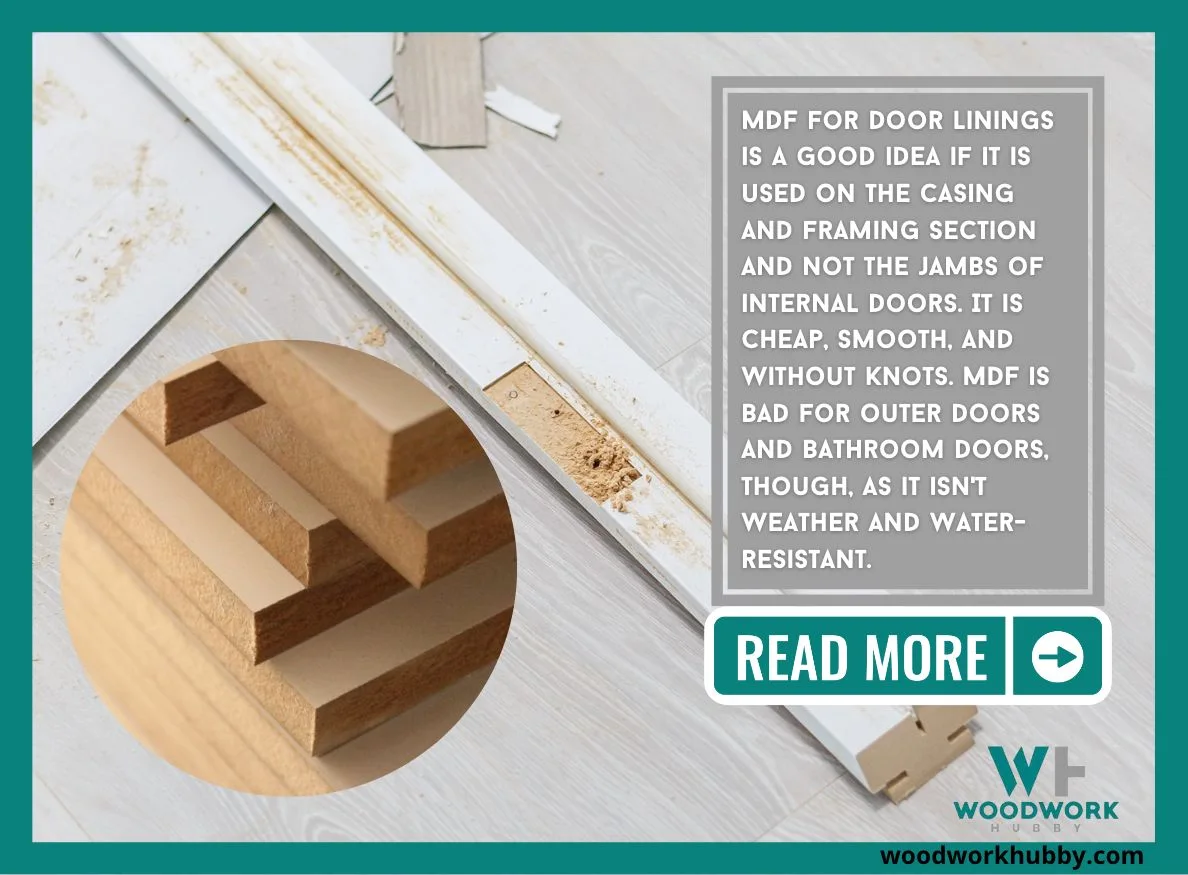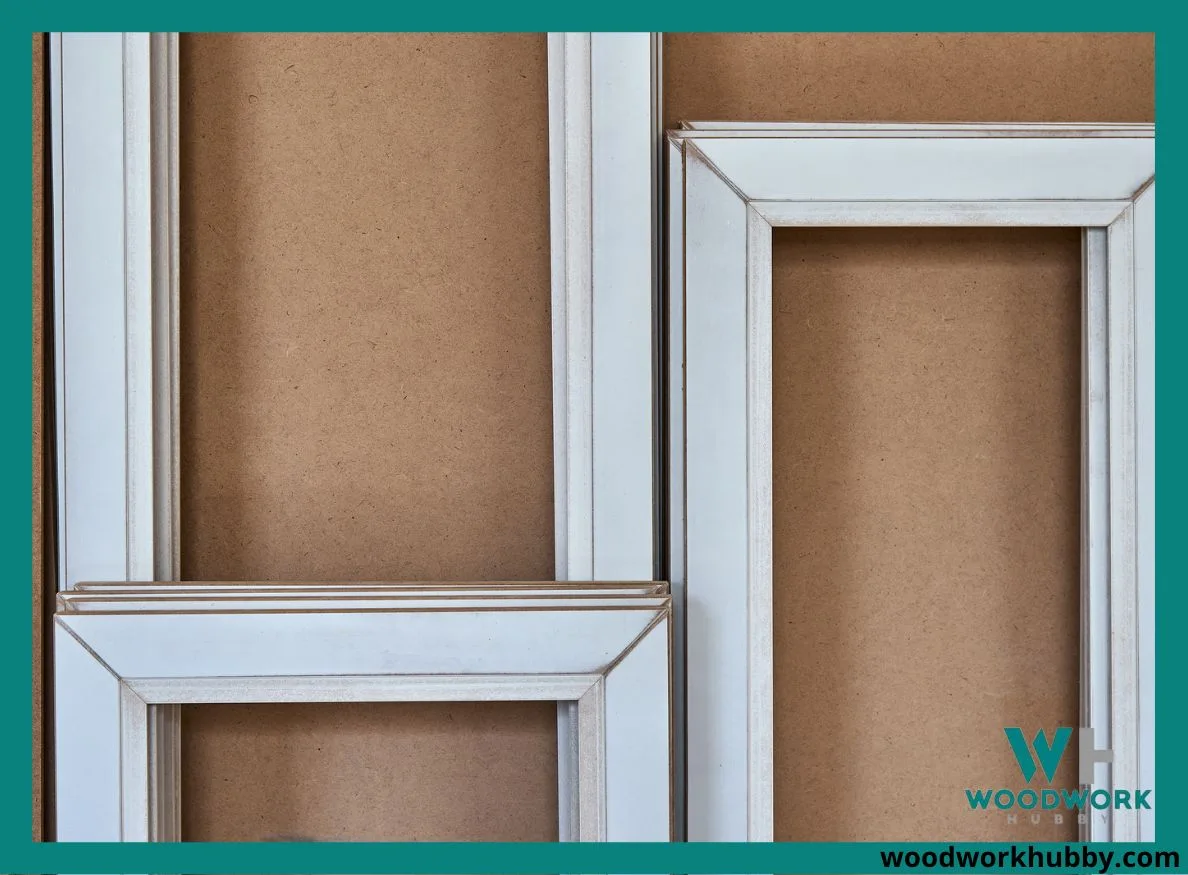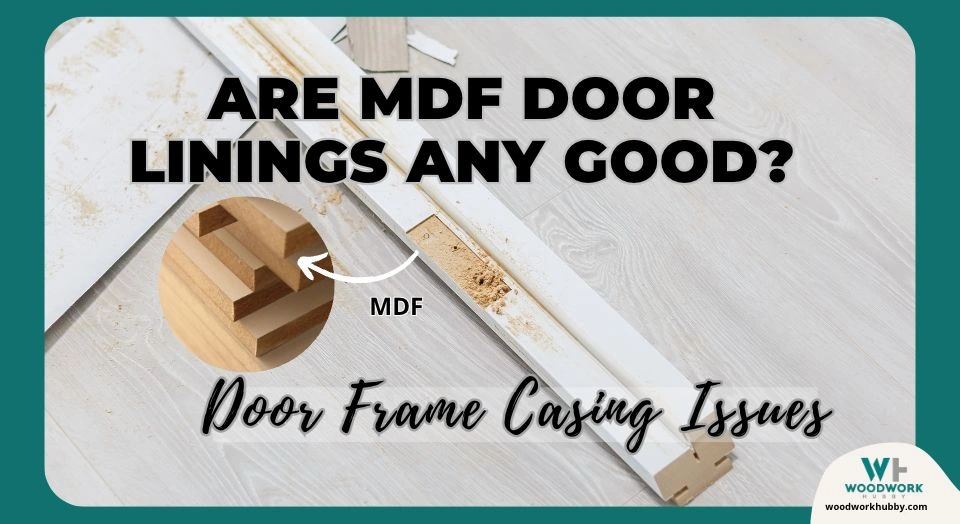During my years as a cabinetmaker, I noticed a lot of new homes were opting for MDF door linings and MDF door frames. MDF certainly helps with cost-cutting but I was always hesitant and wondered are MDF door linings any good. I sort of knew the answer but thought I would put some research into this for you.
In general, MDF can be used for door linings and jambs of internal doors only provided they are not exposed to moisture such as in wet areas like bathrooms and laundries. It is a cost-effective alternative to natural wood but caution should be used when considering it.
In this article, I detail the upsides and downsides of using MDF for different aspects of door lining, casing, or framing. You will also find out what door frames are made out of aside from MDF and how MDF compares to those materials.

By the end of this post, you will know what to use for your door lining. But before going into alternative materials, let’s look at the feasibility of MDF for door frames.
Video showing MDF being used as door linings
Can You Use MDF For Door Frames?
You can use MDF for door frames as long as the doors don’t belong to the bathroom or other wet areas. The material limitations of MDF, like zero water resistance, alongside its advantages, like no warps or faults, apply to door frames made from MDF.
So, technically you can use MDF for door frames but whether that is the best choice depends entirely on your situation. In this section, I want to get into a few factors worth considering before choosing MDF for the door frames.
- Budget – If you are on a tight budget, MDF is going to be a pretty good choice as it is relatively cheaper than almost any material used for door linings, frames, and jamb.
- Material selection – If you aren’t good at lumber selection, you risk bringing home material with faults and knots. MDF is flawless, and you need no knowledge of woodworking when you get it. As long as the MDF fits the dimension and weight specs, it will be perfect for the door.
- Proximity to water – This is perhaps the single most important factor in choosing MDF for door linings. The same MDF that can be great for a living room door can be a poor choice for a bathroom. If you live in a rainy region, you might want to keep MDF out of your front door’s frame as well.
If you don’t use MDF from the front door or the bathroom door, the rest of the specifics are all upsides. You get a cheap frame material that isn’t likely to have faults and flaws. In case you have MDF already and plan to use it, you can take this as a confirmation that the material works for most door lining and frame projects.
But if you have not bought MDF yet, then it is fair to compare it with other options as they might suit you more. Let’s look at what other than MDF can be used for door linings.
What Kind Of Wood Is Used For Door Linings?
Pine and poplar are used for interior door linings, and Teak is used for the exterior. Since Teak repels insects and resists water better than other types of wood, it is ideal for the outdoor casing.
What’s needed from the frame wood of a door is softness yet passable structural strength alongside straightness and dimensional stability. The last thing you want from the frame wood is warping. If the wood warps or is disfigured in any way after it is used in the lining, the door can get stuck.
You can use pretty much any material for door lining as long as it is straight and smooth, dimensionally stable, relatively durable, and softer than the material of the door. Here is why each of those properties matters.
- Straight and smooth – The straighter the lining of the door, the better it looks. Moreover, the straighter the jamb, the more smoothly the door opens. You also don’t want blisters from leaning against the door frame, which can happen with a few types of wood.
- Dimensional stability – The more dimensionally stable the frame wood is, the less likely it is to cause problems after seasons change. With humidity changes, the size of the wood might expand or contract. To some extent, the measurements of the door frame should take this into account. But to a larger degree, the actual material should retain its dimensions.
- Relatively durable – This one is pretty straightforward. Doors are high-use surfaces, and, depending on how mad you make your spouse, the door frame can receive harsh punishment. The more durable the material, the longer it lasts. MDF, unfortunately, isn’t very durable.
- Softer than the door – Finally, you need the door lining to have lower Janka hardness than the door material. This way, the door cannot get stuck even if there is a little congestion in the mechanism. The door can eat into the frame, making room for seamless opening and closing, even if the lining gets into the door’s space.
Now we have covered the wood types used for door casing as well as the features that make them great in that use case. Let’s compare how MDF and these woods perform along these dimensions.
| Factor | MDF | Poplar/Pine | Teak |
|---|---|---|---|
| Straightness | MDF is straighter than wood | Straight enough | Can have issues with straightness, but occasionally |
| Dimensional Stability | MDF is dimensionally stable | Both are dimensionally stable | Pretty stable |
| Durability | Not as durable as solid wood | It is more durable than MDF but less than Teak | Is the most durable option in this comparison |
| Weather Resistance | MDF has low weather resistance | Poplar and Pine need finishing to be weather resistant | Teak is weather resistant |
The comparison above shows that MDF is perfect for door lining in many aspects but gets beaten in durability and weather resistance. In my estimation, this makes MDF perfect for the casing and frame part of internal doors.
The MDF door casing doesn’t get slammed or rubber, and when we talk about the internal door’s casing, weather resistance becomes irrelevant.
If MDF is great for the casing, then what’s ideal for the jamb? That’s the question. You need wood that has all the upsides of MDF but without the durability lapse and the poor weather resistance of MDF. Moisture resistant MDF is available but at a much higher price.
What Kind Of Wood Is Best For A Door Jamb?
The best kind of wood for a door jamb is Teak because it is dimensionally stable, pretty straight, and above all, weather and bug-resistant. While the door hands above the floor, the side jambs touch the ground, which can be a point of contact for infestations.
Teak is pretty hard, though, which means that if the door is stuck, it won’t eat into the teak jamb and open anyway. That’s why you have to be careful enough to leave room for Teak to breathe. It is a type of wood famous for breathing.
Still, Teak is one of the best wood types for door frames, especially when it comes to outer doors. Because the outer doors are exposed to the elements and can get drenched in water, they definitely cannot be made from MDF or wood that rots too easily. The more it rains in your region, the less ideal it is to have MDF anywhere in an outer door’s frame.
Can You Use MDF For Internal Doors?
You can use MDF for internal doors and door frames because it is smooth, solid, and has a balanced weight. If MDF is used for internal doors or door frames, it must be allowed to acclimate in the atmosphere of the house so that the door doesn’t get stuck.
Let’s dive deeper into the advantages of using MDF for internal doors alongside the drawbacks. Knowing both, you will be in a better position to decide which way to go. But even before getting into that, I want you to know that if you have enough MDF around to use for internal doors, go for it.
No drawback in this section is significant enough to throw out MDF that you already have. But if you’re thinking of buying MDF specifically for internal doors, then a comparison of the pros and cons can help.
A video showing how to make MDF doors.
The pros of using MDF for internal doors are:
- MDF is faultless – MDF doesn’t have knots and flaws like standard wood. Getting it is easier, even if you are not good at the material selection. MDF is made from many wood fibers pressured into a smooth panel, held together with adhesive. It is impossible to have knots in such a structure.
- MDF doesn’t warp – MDF doesn’t expand and shrink unevenly, which is why you find it bending out of shape. This is obviously important for a door. Any warping could prevent a door from opening or make it harder to shut.
- MDF breathes half as much as wood – Changes in humidity and temperature, therefore, don’t affect MDF’s size as much as they affect the size of wood. The more solid wood expands and shrinks, the higher risk your door is of warping or getting stuck.
- MDF is cheaper than most solid wood – MDF is made from wood fibers instead of solid wood, which reduces the cost of production. It is, therefore, the cheaper solution.

The cons of using MDF for internal doors are:
- MDF is easy to scratch – MDF is hard but not as hard as most wood doors. While wood doors also incur scratches, MDF doors get scratched more often. If you have pre-teens at home, then MDF doors might not be great.
- MDF is hard to repair – While scratched wood doors can be evened out with a wood filler, it is hard to even out MDF. Even water damage, impact damage, and loosening of fixtures are harder to fix. Because of this, MDF doors do not last very long.
- MDF cannot be exposed to extreme heat – Extreme heat can liquify the glue that holds MDF’s wood fibers together. If the wood fibers start to shift, they can never go back into shape. It isn’t likely to have as hot an environment in one’s home, so internal doors made from MDF won’t usually have this issue.
- MDF cannot handle too much humidity – MDF is a little moisture-resistant, but its weather resistance is nothing to write home about. Even in internal doors, extreme humidity shifts can be a cause of degradation. Invest in a dehumidifier if you have MF doors.
Here is a table showing my recommended products for door linings.
Final Thoughts – MDF for linings and skirting boards?
MDF door lining is a good idea in most contexts other than the bathroom door, the kitchen door’s interior, and the front door’s exterior. I would keep MDF out of the front door’s internal casing as well.
But as far as internal doors go, MDF can make up not just the frame but the entire door. Just make sure to acclimate the MDF before you start working with it, and keep the internal temperature and humidity levels MDF-friendly.




